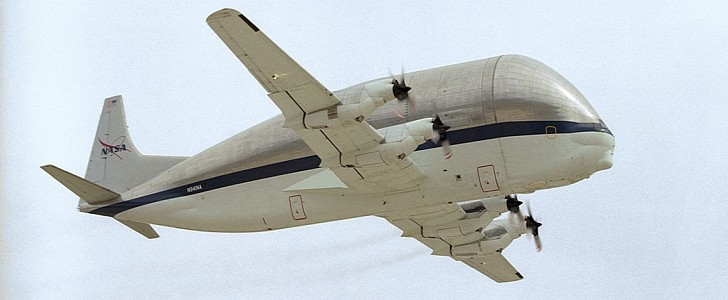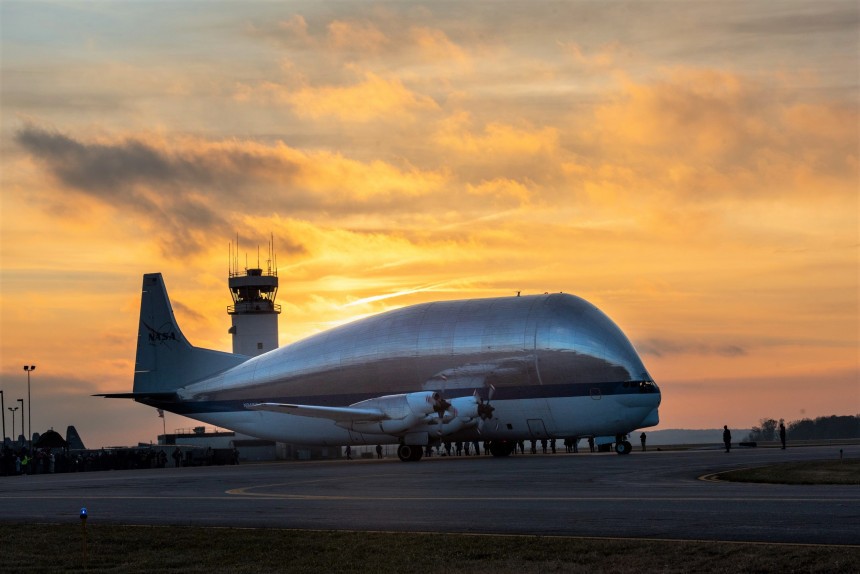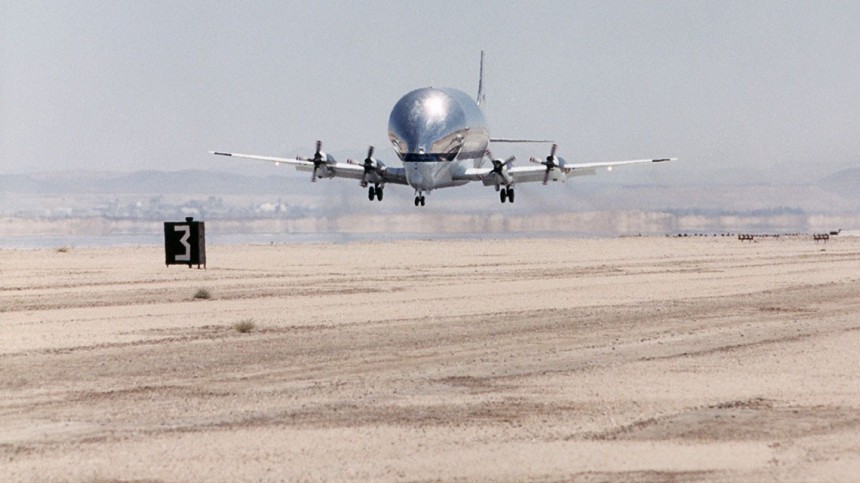Transporting large pieces of spacecraft has always been a difficult task. And when you're racing to get back to the Moon, you need all the help you can get. As oddly as it might sound, NASA's help comes from an aircraft shaped like a massive whale. Called the Super Guppy, this aircraft has recently been busy carrying essential cargo, which will ultimately support the astronauts' return on the lunar surface.
It's a bizarre-looking aircraft, but it has played a crucial role since it first entered service in 1961: helping America win the space race. Produced by Aero Spacelines, the first model was called the Pregnant Guppy since it resembled a bloated fish. It had its fuselage made from a heavily modified Boeing KC-97 Stratotanker, and it featured a massive cargo bay that measured 19 ft (6 meters) in diameter.
It was the largest compartment ever built on an aircraft at the time. Thanks to the Pregnant Guppy, NASA could carry critical large cargo to its launch facilities in record time.
The program was so successful that an even larger version of the aircraft was built a few years later. Dubbed the Super Guppy, it had a significantly bigger cargo bay that measured 25 ft (7.6 m) in diameter. That's not the only modifications it received, though. It also received extra power from Pratt & Whitney T-34-P-7WA turboprop engines, as well as a pressurized cockpit and a hinged nose that would allow the plane to "swallow" up the cargo. The plane was owned and operated by Aero Spacelines until NASA purchased it in 1979.
The Super Guppy Turbine is the final version of Guppy aircraft, and only four were ever built. The most significant difference between the Turbine and its predecessor was the new Allison T-56 turboprop engines that were more reliable and accessible.
For more than three decades, the whale-shaped aircraft flew over three million miles and played a significant role in NASA's Apollo missions. Today, the Super Guppy continues to support the agency's space programs. In addition, these past few years, the plane has been assisting the Department of Defense and government contractors in moving aircraft and big components across the continent.
More recently, it has been helping NASA prepare for the Artemis IV mission, the third crewed mission to the Moon. Through the Artemis program, the space agency plans to land the first woman and the next man on the lunar surface by the end of the decade and develop infrastructure on the satellite, setting the foundation for the next stop: Mars.
On November 9th, the Super Guppy carried in its "belly" the heat shield skin for the future mission, which will be installed on the Orion spacecraft. It's a crucial cargo set to protect the capsule and Artemis astronauts who'll be riding inside.
When the crew returns home from the Moon, the Orion will plunge back into Earth's atmosphere at roughly 25,000 mph (40,000 kph). The heat generated during re-entry will be half as hot as the Sun. The heat shield is designed to withstand that scorching temperature thanks to an underlying titanium skeleton covered by carbon fiber skin.
The Orion heat shield and its corresponding skin is the biggest such structure yet designed for human spaceflight missions, measuring 16.5 ft (5 meters) in diameter. There's no other aircraft better suited that can swallow up this cargo. The Super Guppy's nose opens to a 110-degree angle, allowing the components to be easily loaded and unloaded from its belly. The aircraft's strange design also allows it to transport heavy equipment that would otherwise not fit aboard a standard plane.
The heat shield skin is now at Moffett Federal Airfield and will undergo heat- and pressure treatment at Lockheed Martin's facility in Sunnyvale, California. As for the Super Guppy, it will continue to help NASA deliver the necessary parts that will help humanity establish a long-term presence on our natural satellite.
It was the largest compartment ever built on an aircraft at the time. Thanks to the Pregnant Guppy, NASA could carry critical large cargo to its launch facilities in record time.
The program was so successful that an even larger version of the aircraft was built a few years later. Dubbed the Super Guppy, it had a significantly bigger cargo bay that measured 25 ft (7.6 m) in diameter. That's not the only modifications it received, though. It also received extra power from Pratt & Whitney T-34-P-7WA turboprop engines, as well as a pressurized cockpit and a hinged nose that would allow the plane to "swallow" up the cargo. The plane was owned and operated by Aero Spacelines until NASA purchased it in 1979.
The Super Guppy Turbine is the final version of Guppy aircraft, and only four were ever built. The most significant difference between the Turbine and its predecessor was the new Allison T-56 turboprop engines that were more reliable and accessible.
More recently, it has been helping NASA prepare for the Artemis IV mission, the third crewed mission to the Moon. Through the Artemis program, the space agency plans to land the first woman and the next man on the lunar surface by the end of the decade and develop infrastructure on the satellite, setting the foundation for the next stop: Mars.
On November 9th, the Super Guppy carried in its "belly" the heat shield skin for the future mission, which will be installed on the Orion spacecraft. It's a crucial cargo set to protect the capsule and Artemis astronauts who'll be riding inside.
The Orion heat shield and its corresponding skin is the biggest such structure yet designed for human spaceflight missions, measuring 16.5 ft (5 meters) in diameter. There's no other aircraft better suited that can swallow up this cargo. The Super Guppy's nose opens to a 110-degree angle, allowing the components to be easily loaded and unloaded from its belly. The aircraft's strange design also allows it to transport heavy equipment that would otherwise not fit aboard a standard plane.
The heat shield skin is now at Moffett Federal Airfield and will undergo heat- and pressure treatment at Lockheed Martin's facility in Sunnyvale, California. As for the Super Guppy, it will continue to help NASA deliver the necessary parts that will help humanity establish a long-term presence on our natural satellite.









